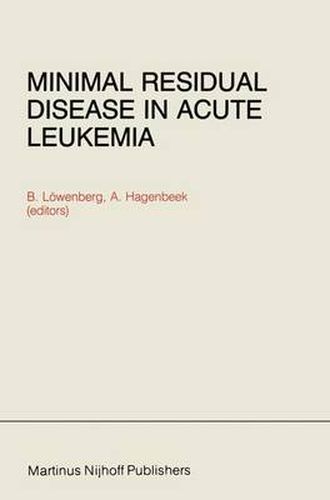Readings Newsletter
Become a Readings Member to make your shopping experience even easier.
Sign in or sign up for free!
You’re not far away from qualifying for FREE standard shipping within Australia
You’ve qualified for FREE standard shipping within Australia
The cart is loading…






The objective of the treatment of acute leukemia involves the eradication of all neoplastic cells, including the last one. Ideally, treatment should be controlled by monitoring cell kill. If the last cells could be discovered and their biological properties be determined, the qualitative and quantitative effects of treatment should be directly evaluable. This should ultimately permit a calculated tumor cell reduction thereby avoiding overtreatment and excessive toxicity and thus providing a basis for individualized antileukemic treatment. In recent years several new developments have contributed to the selective discovery of minimal numbers of leukemic cells which are hidden among the normal cells in the marrow cavities. These methods are the first steps to the realization of the therapeutic goals indicated above. They include the production and ap- plication of monoclonal antibodies against differentiation antigens on the cell sur- face, the use of pulse cytophotometry - and cell sorter techniques, the employment of cytogenetics, the development of culture techniques for selective growth of precursor cells and several others. These methodologies offer prospects for refined diagnosis and, as far as the elimination of leukemic cells is concerned, the further development of autologous bone marrow transplantation. Eliminating tumor cells from autologous grafts requires the detailed knowledge of the cellular inter- relationships within the neoplasm so that the neoplastic cells responsible for tumor propagation are specifically removed. Recognition and characterization of the clonogenic cells of the neoplasm should then lead to determining their sensitivity to the therapeutic agents which are clinically applied.
$9.00 standard shipping within Australia
FREE standard shipping within Australia for orders over $100.00
Express & International shipping calculated at checkout
The objective of the treatment of acute leukemia involves the eradication of all neoplastic cells, including the last one. Ideally, treatment should be controlled by monitoring cell kill. If the last cells could be discovered and their biological properties be determined, the qualitative and quantitative effects of treatment should be directly evaluable. This should ultimately permit a calculated tumor cell reduction thereby avoiding overtreatment and excessive toxicity and thus providing a basis for individualized antileukemic treatment. In recent years several new developments have contributed to the selective discovery of minimal numbers of leukemic cells which are hidden among the normal cells in the marrow cavities. These methods are the first steps to the realization of the therapeutic goals indicated above. They include the production and ap- plication of monoclonal antibodies against differentiation antigens on the cell sur- face, the use of pulse cytophotometry - and cell sorter techniques, the employment of cytogenetics, the development of culture techniques for selective growth of precursor cells and several others. These methodologies offer prospects for refined diagnosis and, as far as the elimination of leukemic cells is concerned, the further development of autologous bone marrow transplantation. Eliminating tumor cells from autologous grafts requires the detailed knowledge of the cellular inter- relationships within the neoplasm so that the neoplastic cells responsible for tumor propagation are specifically removed. Recognition and characterization of the clonogenic cells of the neoplasm should then lead to determining their sensitivity to the therapeutic agents which are clinically applied.